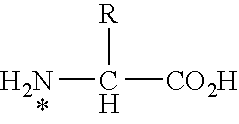Methods and compositions for the modulation of amino acid biosynthesis
a biosynthesis and amino acid technology, applied in the field of molecular biology, can solve the problems of limited success, affecting the use of nutritionally superior plant mutants and tissues, and affecting the nutritional value of seed or grain, and achieve the effect of increasing the nutritional value of seeds or grains
- Summary
- Abstract
- Description
- Claims
- Application Information
AI Technical Summary
Benefits of technology
Problems solved by technology
Method used
Image
Examples
example 1
Transformation and Regeneration of Maize
[0149]Immature maize embryos from greenhouse donor plants are bombarded with a plasmid containing an amino acid-N-acetyltransferase operably linked to a promoter of interest and the selectable marker gene PAT (Wohlleben et al. (1988) Gene 70:25-37), which confers resistance to the herbicide Bialaphos. Alternatively, the selectable marker gene is provided on a separate plasmid. Transformation is performed as follows. Media recipes follow below.
[0150]The ears are husked and surface sterilized in 30% Clorox bleach plus 0.5% Micro detergent for 20 minutes, and rinsed two times with sterile water. The immature embryos are excised and placed embryo axis side down (scutellum side up), 25 embryos per plate, on 560Y medium for 4 hours and then aligned within the 2.5 cm target zone in preparation for bombardment.
[0151]A plasmid vector comprising the amino acid-N-acetyltransferase operably linked to the promoter of interest is made. This plasmid DNA plus...
example 2
Agrobacterium-Mediated Transformation of Maize
[0159]For Agrobacterium-mediated transformation of maize with an amino acid-N-acetyltransferase, the method of Zhao is employed (U.S. Pat. No. 5,981,840, and PCT patent publication WO98 / 32326; the contents of which are hereby incorporated by reference). Briefly, immature embryos are isolated from maize and the embryos contacted with a suspension of Agrobacterium, where the bacteria are capable of transferring the amino acid-N-acetyltransferase to at least one cell of at least one of the immature embryos (step 1: the infection step). In this step the immature embryos are immersed in an Agrobacterium suspension for the initiation of inoculation. The embryos are co-cultured for a time with the Agrobacterium (step 2: the co-cultivation step). The immature embryos are cultured on solid medium following the infection step. Following this co-cultivation period an optional “resting” step is contemplated. In this resting step, the embryos are inc...
example 3
Soybean Embryo Transformation
[0160]Soybean embryogenic suspension cultures (cv. Jack) are maintained in 35 ml liquid medium SB196 (see recipes below) on rotary shaker, 150 rpm, 26° C. with cool white fluorescent lights on 16:8 hr day / night photoperiod at light intensity of 60-85 μE / m2 / s. Cultures are subcultured every 7 days to two weeks by inoculating approximately 35 mg of tissue into 35 ml of fresh liquid SB196 (the preferred subculture interval is every 7 days). Soybean embryogenic suspension cultures are transformed with the plasmids and DNA fragments described in the following examples by the method of particle gun bombardment (Klein et al. (1987) Nature, 327:70). Soybean cultures are initiated twice each month with 5-7 days between each initiation.
[0161]Pods with immature seeds from available soybean plants 45-55 days after planting are picked, removed from their shells and placed into a sterilized magenta box. The soybean seeds are sterilized by shaking them for 15 minutes i...
PUM
| Property | Measurement | Unit |
|---|---|---|
| physiological ionic strength | aaaaa | aaaaa |
| average diameter | aaaaa | aaaaa |
| time | aaaaa | aaaaa |
Abstract
Description
Claims
Application Information
 Login to View More
Login to View More - R&D
- Intellectual Property
- Life Sciences
- Materials
- Tech Scout
- Unparalleled Data Quality
- Higher Quality Content
- 60% Fewer Hallucinations
Browse by: Latest US Patents, China's latest patents, Technical Efficacy Thesaurus, Application Domain, Technology Topic, Popular Technical Reports.
© 2025 PatSnap. All rights reserved.Legal|Privacy policy|Modern Slavery Act Transparency Statement|Sitemap|About US| Contact US: help@patsnap.com

